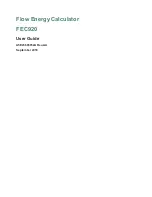
FEC920: USER GUIDE
Page 2
September 18
1.
This instrument is intended for industrial temperature and process control applications within the
requirements of the European directives on safety and EMC.
2.
Installation may be carried out only by qualified personnel.
3.
To prevent hands or metal tools coming into contact with parts that are electrically live the instrument
must be installed in an enclosure.
4.
Where conductive pollution (e.g. condensation, carbon dust) is likely, adequate air conditioning/filtering/
sealing etc. must be installed in the enclosure.
5.
The mains supply fuse within the power supply is not replaceable. If it is suspected that the fuse is faulty,
the manufacturer’s local service centre should be contacted for advice.
6.
Whenever it is likely that protection has been impaired, the unit shall be made inoperative, and secured
against accidental operation. The manufacturer’s nearest service centre should be contacted for advice.
7.
If the equipment is used in a manner not specified by the manufacturer, the protection provided by the
equipment might be impaired.
8.
The unit must be wired according to the instructions in this manual.
9.
Before any other connection is made, the protective earth terminal shall be connected to a protective
conductor. The mains (supply voltage) wiring must be terminated in such a way that, should it slip, the
Earth wire would be the last wire to become disconnected. The protective earth terminal must remain
connected (even if the equipment is isolated from the mains supply), if any of the I/O circuits are
connected to hazardous voltages*.
The protective earth connection must always be the first to be connected and the last to be disconnected.
Wiring must comply with all local wiring regulations, e.g. in the UK, the latest IEEE wiring regulations
(BS7671) and in the USA, NEC class 1 wiring methods.
10. Signal and supply voltage wiring should be kept separate from one another. Where this is impractical,
shielded cables should be used for the signal wiring.
11. The maximum continuous voltage applied between any of the following terminals must not exceed 240Vac.
1. Relay output to logic, dc or sensor input connections.
2. Any connection to ground.
The ac supply must not be connected to sensor input or low-level inputs or outputs.
12. Over temperature protection: A separate over-temperature protection unit (with an independent
temperature sensor) should be fitted to isolate the process heating circuit should a fault condition arise.
Alarm relays within the recorder/controller do not give protection under all fault conditions.
13. In order to allow the power supply capacitors to discharge to a safe voltage, the supply must be
disconnected at least two minutes before the instrument is removed from its sleeve. The touching of the
exposed electronics of an instrument which has been removed from its sleeve should be avoided.
14. Instrument labels may be cleaned using iso-propyl alcohol, or water or water-based products. A mild soap
solution may be used to clean other exterior surfaces.
* A full definition of ‘Hazardous’ voltages appears under ‘Hazardous live’ in BS EN61010. Briefly, under normal
operating conditions, hazardous voltages are defined as being > 30V RMS (42.2V peak) or > 60Vdc.
A5E45696052A Rev-AA
Содержание SITRANS FEC920
Страница 1: ...Flow Energy Calculator FEC920 User Guide A5E45696052A Rev AA September 2018 ...
Страница 247: ......










































